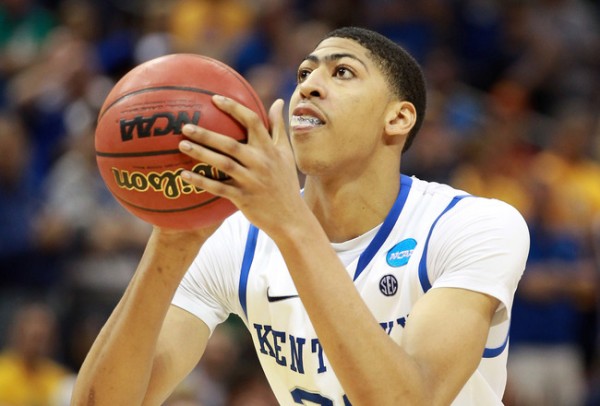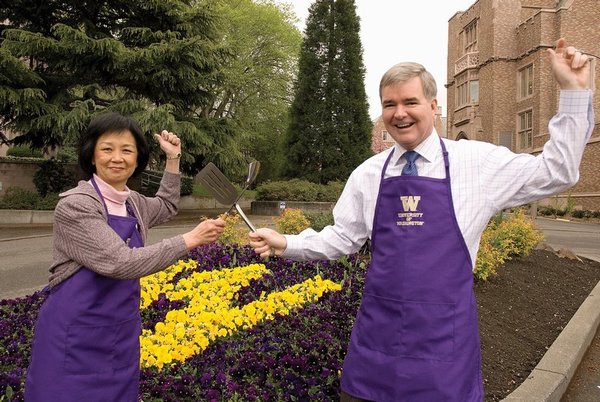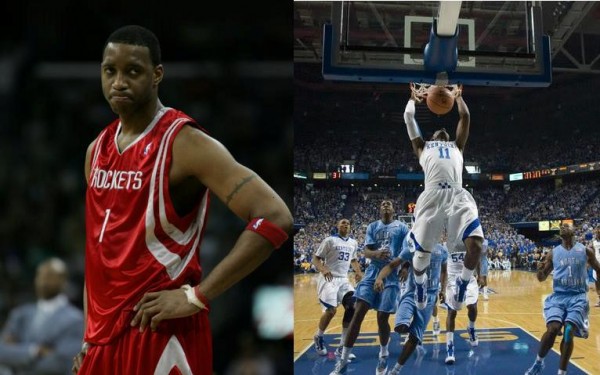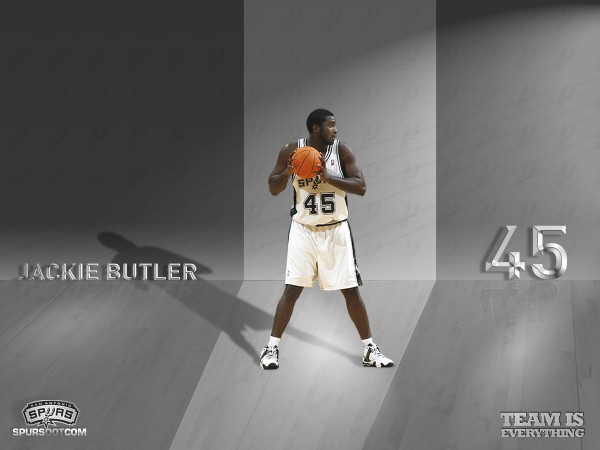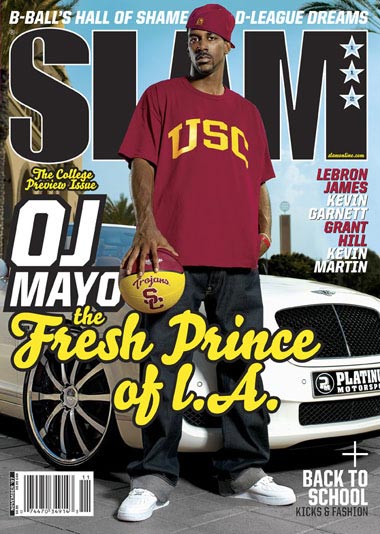Well this is sort of unplanned, but rtmsf asked me to do this and I’ve got nothing else to do tonight so I figured I would throw up a live blog of the events.
7:30 PM: Everybody’s favorite commissioner/megalomanic David Stern walks to the stage. Pretty weak response from the crowd. Minimal booing and almost no response to a mention of the WNBA. I think Isiah and Dolan have broken the New York fans.
7:38 PM: Stern announces the Bulls’ selection of Derrick Rose. Kind of anti-climatic, but surprising how quickly the consensus swung from Michael Beasley to Rose in such a short time without anything really big coming out (other than Beasley being shorter than advertised, but the decision was already made at that point).
7:40 PM: ESPN shows some highlights of Rose winning the state championship game 31-29 in OT. Yes, 31-29. I guess the lack of offense in the Big 10 goes all the way down to the high school level.
7:42 PM: Stern comes to the podium with the Miami Heat’s pick. . .Michael Beasley. For all the talk about going with O.J. Mayo I always thought this was a no brainer. I mean they could have dropped down to the #5 pick, but I don’t buy the whole Rudy Gay + #5 for #2 trade. There’s no way Memphis would have done that. Does Pat Riley think Chris Wallace is an idiot? Oh wait. . .
7:45 PM: The interviews have been pretty tame so far. Beasley could have at least pulled the dead rat “joke” on Stephen A. Smith. The Stephen A. Smith guys better have something good planned for the draft because this is pretty weak so far.
7:48 PM: Minnesota is up. Time for Kevin McHale to shine. And the pick is. . . O.J. Mayo! Why do I have flashbacks to KG and Stephon Marbury. Stu Scott fills us in on O.J.’s full name. Thanks for that since we haven’t seen it in every single article written about him (except on RTC). At least O.J.’s time in Hollywood got him prepared for the bright lights of Minnesota. Wait, Minnesota?
7:50 PM: If you’re reading this after the draft and wondering why the writing sucks, blame it on the stupid 5 minutes between picks. There’s no way Bill Simmons live blogs this stuff. It’s impossible. He has to take 3-4 hours after the draft to put something together.
7:53 PM: Wow. Six picks for Seattle. Stu Scott with the quick math (6/60 = 1/10th). I’m not sure why they didn’t do some kind of big package to try and get some help for Kevin Durant.
7:54 PM: Stern with the pick. . .Russell Westbrook! Our first surprise of the night. I had heard Westbrook might be top 5, but never really believed it. The guy’s athletic, but I just don’t see how he’s considered the 4th best prospect in this draft. If you’re just going on athleticism, I’d take Eric Gordon over Westbrook. As for his “great” defense, I don’t remember it against Memphis and Rose. Plus I don’t buy Westbrook as a NBA point guard.
7:58 PM: Commercial break. Weak start to the draft so far. At least we have the comedy of the booing of the Knicks draft pick to look forward to in 2 picks.
8:00 PM: Bilas is pushing for Memphis to take Kevin Love. Stern with the announcement. And it’s Kevin Love. Nice call by Bilas even if Love basically gave it away on PTI earlier this week. I’m pretty sure the first time that anybody has ever had the Color Me Badd facial hair in Memphis.
8:03 PM: Pretty routine breakdown of Love. Good court sense/knowledge of the game, passes well, good range, and can’t run the court. Can we have someone disagree with a pick? I just want to see the player’s reaction (not to mention what their mom will do).
8:05 PM: Waiting for the Love family interview to finish so I can see the Knicks screw up their pick. This is the highlight of the night. . .
8:07 PM: Stern walking to the podium with the Knicks pick. . .(dramatic pause). . .Danilo Gallinari. BOOOOOOOOOOOO! Sorry. Just had to join in the fun. I don’t really buy Gallinari, but hey the YouTube video looks decent and that worked out well for guys like Kwame Brown and Eddy Curry worked out great, right? (Yes, I know that was before YouTube).
8:08 PM: Fran Fraschilla offers the most important piece of news of the night (for those of us who read Deadspin or The Big Lead). “Gallo” is apparently the Italian word for “rooster”. If you’ve read the posts on either site yesterday, you’ll know what that’s important.
8:12 PM: The Clippers select Eric Gordon. I feel bad for the guy. He goes from the most dysfunctional program in the country to the worst franchise in pro sports. Love the guy’s game, but he’s just too inconsistent at times. It will be interesting to see how this plays out.
8:15 PM: Our first horrible suit of the night. Gordon with the combination of white coat and navy blue pants. Not quite Karl Malone level, but you would figure his high school agent could have gotten him something nice.
8:18 PM: Joe Alexander to Milwaukee. At least it won’t be much of a culture shock going from Morgantown to Milwaukee although Joe won’t be seeing as many burning couches.
8:23 PM: MJ and Larry Brown are on the clock. It seems like Brook Lopez is the choice here. The Bobcats certainly have enough college talent on that team being veterans of the lottery process (tip of the hat to the legend Elgin Baylor).
8:24 PM: Jay Bilas and Mark Jackson agree with me.
8:25 PM: But apparently MJ and Larry do not. The Bobcats take D.J. Augustin. Looks like Raymond Felton is going to have some competition. This seems like a good pick for a trade.
8:27 PM: I still don’t get it. Of course, MJ was also the mastermind behind the Kwame Brown selection so maybe I shouldn’t.
8:28 PM: So it looks like Brook Lopez here to New Jersey. They can’t take Jerryd Bayless since they already have Devin Harris. This will be an interesting pick since they just traded away Richard Jefferson for Yi Jianlian and Bobby Simmons.
8:30 PM: Brook Lopez at #10 to New Jersey. Solid pick especially this far down. I’m surprised that he fell down this far. A 7-footer with a mean streak and solid fundamentals. Usually guys like this go too high and typically don’t slip. Not sure what is going on.
8:33 PM: Wow. Looks like our first classic draft moment of 2008. Apparently Jeff Spicoli dressed up as a 7-foot tall guy who went to Stanford. I wish I had been there for Brook’s Stanford interview. What? You mean he didn’t go through the regular admissions process?
8:35 PM: Bayless at #11. I like Bayless at #11, but does Indiana need another guard? Jamaal Tinsley, T.J. Ford, and Bayless. Looks like Tinsley and his gun collection are moving out of Indiana.
8:42 PM: Sacramento takes Jason Thompson. Our first real surprise pick of the draft. I’m actually ashamed to say I have never seen this guy play. Bilas says he’s pretty good so I guess I’ll have to go with that.
8:46 PM: Portland at #13. . .Brandon Rush. Interesting pick. He’ll probably fit in well with this team. He isn’t a star, but they have enough young talent that they don’t need him to be more than a solid role player. He’ll probably back-up Brandon Roy for the next couple of years.
8:50 PM: Golden State is on the clock. This is the part of the draft where teams have a lot of choices. Let’s see what the Warriors do.
8:51 PM: Stern with the pick: Anthony Randolph. 3rd team All-SEC member. Even the LSU blogger doesn’t believe in him. Not sure what else I have to say about this pick.
8:54 PM: Dick Vitale ripping the international. Comparing Gallinari to Darko Milicic. Ouch. Not a surprise since Dickie V loves all things college (as do we, but we don’t rip on the other stuff).
8:56 PM: Phoenix takes Robin Lopez at #15. I’ll admit it. I’m hitting the wall here so I’m probably only going to make it through the first round. I actually like this pick. Robin isn’t an offense force, but is a pretty good defender, which Phoenix is lacking.
9:03 PM: With the 16th pick, Philadelphia selects Maureese Speights. Seems like a talented player. It will be interesting to see how he works with Samuel Dalembert. Wow. Stuart Scott just compared FG% in college to FG% in the NBA as if it’s the same thing. I don’t even know what to say to that.
9:08 PM: Toronto selects Roy Hibbert at #17 for Indiana (part of the Jermaine O’Neal trade). This makes sense. Hibbert will “replace” O’Neal. It’s too bad that Hibbert fell this far. He would have been a top 10 pick last year. He didn’t get injured or play poorly, but because he never exploded like NBA scouts hoped he would he fell far enough down that it probably cost him a few million dollars.
9:12 PM: JaVale McGee at #18 to Washington. Looks like Lebron has another guy to dunk on.
9:15 PM: Pretty interesting trade. Indiana gets Jarrett Jack and Brandon Rush for Ike Diogu and Jerryd Bayless to Portland. Bayless and Roy make a really scary potential backcourt dishing the ball off to Greg Oden and company.
9:19 PM: Cleveland is on the clock. This pick is big for Danny Ferry because it might go a long way to keeping Lebron in Cleveland and out of Brooklyn. Darrell Arthur is still sitting in the Green Room. . .
9:21 PM: The Lebrons select J.J. Hickson and Darrell remains seated.
9:26 PM: Charlotte’s on the clock at #20 and take Alexis Ajinca. I’ll turn to Stuart Scott here, “Who is this guy?”
9:28 PM: Wow. I’m pretty sure that’s the first time the economy ever was mentioned in the NBA Draft. Fran informs us that the fall in the dollar’s value will affect Ajinca’s decision whether to stay in Europe. (Side note: Josh McRoberts is part of the Portland-Indiana deal. He’s not worth his own post.)
9:33 PM: The Nets go with Ryan Anderson at #21. Darrell is still sitting. . .
9:38 PM: Looks like Orlando goes with another guard by taking Courtney Lee. I loved Jeff Van Gundy’s analysis. Basically, Dwight Howard and Rashard Lewis are the only two guys he likes on the team–a team that’s coached by his brother. More importantly, what does this do to everybody’s favorite Zima drinker, J.J. Redick?
9:42 PM: Utah takes Kosta Koufos. It will be interesting to see how Koufos fits in with Utah’s bigs (Carlos Boozer, Mehmet Okur, Andrei Kirilenko, and Paul Millsap). He’s a skilled big guy who was really hyped coming in, but was too inconsistent to stay in the top 10. Playing for Jerry Sloan will either toughen him up or turn him into AK-47 (and cry during the playoffs).
9:49 PM: Seattle takes Serge Ibaka. Fraschilla says he’s good and he’ll be here in 3-4 years. Yeah. . .
9:50 PM: Doris Burke interviewing Darrell Arthur. Pretty tame interview. No tears. Not much to say.
9:55 PM: Houston takes Nicolas Batum. Fraschilla compares him to Rudy Gay, which I guess is good. Fran also says he needs to work on his ball-handling and he’s only 20 years old. Since when do people learn how to dribble after they turn 20?
9:58 PM: Ric Bucher announces that Darrell Arthur has a kidney problem, which he says explains why Arthur hasn’t been selected. Sounds like a HIPAA violation somewhere along the line.
10:00 PM: George Hill from IUPUI? Well apparently he plays great defense and has 3% body fat (thanks for that Stuart).
10:08 PM: New Orleans Portland ends the madness and takes Darrell Arthur. Nice moment as the New York fans clap. Nice pickup here. He should be able to come in and spell the big guys for a few minutes here and there immediately.
10:15 PM: Memphis selects Donte Greene. Seems like he’ll be playing behind Rudy Gay for a while. Well at least they got something for giving away Pau Gasol.
10:22 PM: Detroit selects D.J. White. Nice pickup at this position. Productive player who should be a solid guy off the bench for stretches.
10:31 PM: Mercifully, Boston with the last pick of the first round. J.R. Giddens. Wow. What a long ride it’s been for that guy. The former big-time recruit at Kansas who transferred to New Mexico.
Well it’s been a long first round. We’ll be back tomorrow with a more in-depth (and hopefully shorter) analysis.






























